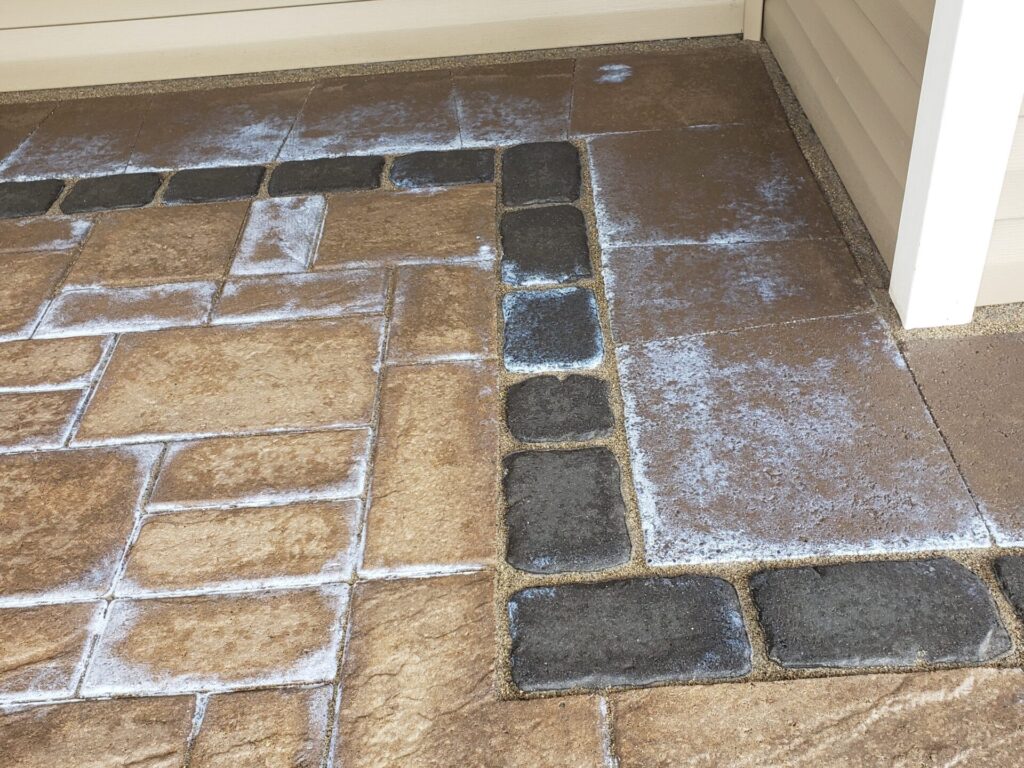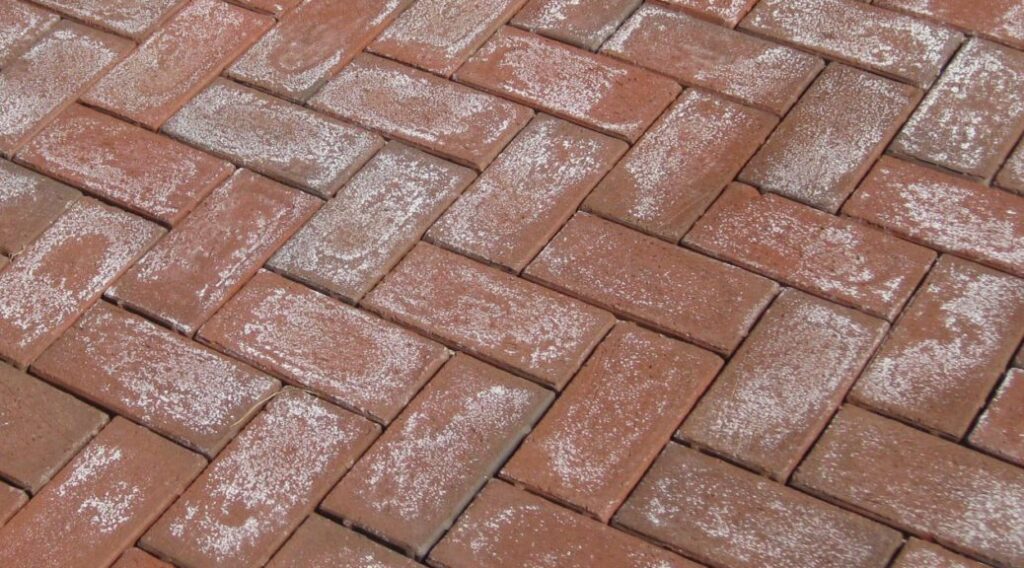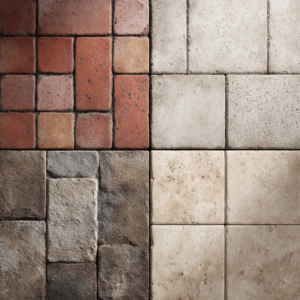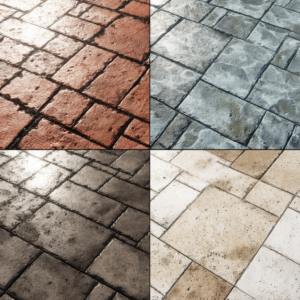Pavers are a versatile and attractive choice for outdoor spaces, adding both aesthetic appeal and functional durability to patios, walkways, and driveways. However, many homeowners may face a common issue: pavers turning white over time. So why do pavers turn white?
This whitening effect, which can be both unsightly and puzzling, is known as efflorescence. In this article, we want to present you with a guide to it.
Our goal is to discuss the science behind efflorescence, the factors that contribute to its occurrence, and how you can prevent and manage it to maintain the beauty of your outdoor surfaces. So let’s get right to it!
Jump to:
Why do pavers turn white? What is efflorescence?

Pavers turn white because of a white, powdery substance that sometimes appears on the surface of pavers called efflorescence. It is a common phenomenon in construction and landscaping, particularly in materials like concrete, brick, and natural stone.
The white residue is primarily composed of calcium carbonate and other soluble salts that have migrated to the surface of the pavers. While efflorescence itself is not harmful to the structural integrity of the pavers, it can detract from their appearance, leading to concerns about the longevity and quality of the installation.
Efflorescence occurs when water-soluble salts present in the paver material are brought to the surface by moisture. The process of how it happens can be broken down into 4 steps:
- Pavers, especially those made from concrete or certain types of natural stone, contain salts within their composition. These salts are naturally occurring and can include compounds like calcium sulfate, sodium sulfate, and calcium carbonate.
- For efflorescence to occur, there must be a source of moisture. Water can penetrate pavers from various sources, such as rain, irrigation systems, groundwater, or even condensation. This moisture dissolves the salts within the pavers, creating a saline solution.
- The saline solution is drawn to the surface of the pavers through a process known as capillary action. This is the same process that allows water to rise through a sponge or a plant stem. The water carries the dissolved salts with it as it moves through the tiny pores and capillaries in the paver material.
- Once the saline solution reaches the surface of the pavers, the water begins to evaporate, leaving the dissolved salts behind. As the water evaporates, the salts crystallize on the surface, forming the characteristic white, powdery residue known as efflorescence.
Read as well: Creative leftover paver ideas – don’t let them go to waste!
Common causes of efflorescence
While the basic process of efflorescence is relatively simple, several factors can influence its occurrence and severity. Understanding these factors can help you take steps to prevent or minimize the impact of efflorescence on your pavers.
The high salt content in pavers is the most common of them. Some pavers are more prone to efflorescence due to their material composition. Concrete pavers, for example, are often made with raw materials that naturally contain higher levels of soluble salts.
Similarly, certain types of natural stone, such as limestone and sandstone, may have a higher salt content, making them more susceptible to efflorescence.
The amount of moisture that comes into contact with the pavers plays a significant role in the development of efflorescence. Areas with heavy rainfall, poor drainage, or high humidity are more likely to experience efflorescence.
Bad drainage around pavers can also contribute to excessive moisture around the pavers, increasing the risk of efflorescence. Most drainage problems can be solved by creating a proper slope during the installation, so be mindful of that.
Other poor installation practices, such as inadequate base preparation or the use of non-permeable materials, can also contribute to moisture retention and the subsequent development of efflorescence.

Efflorescence is most commonly observed in newly installed pavers. This is because freshly manufactured pavers may not have fully cured, leaving them more susceptible to moisture absorption and salt migration.
The curing process allows pavers to harden and stabilize, but until it is complete, the material is more vulnerable to the conditions that cause efflorescence, which is completely normal.
How to prevent and manage efflorescence on pavers
Now you know why pavers turn white and what exactly that white substance is. But how to get rid of it? While efflorescence is a natural and common occurrence, it can be managed and even prevented with the right approach.
Selecting high-quality pavers with low salt content can reduce the likelihood of efflorescence. When choosing pavers, consider working with reputable manufacturers who produce pavers with controlled salt levels and who can provide information about the curing process.
As we mentioned, ensuring that pavers are installed correctly is one of the most effective ways to prevent efflorescence. This includes preparing a well-draining base, using permeable joint materials, and ensuring that the pavers are properly spaced to allow for water drainage.
Applying a high-quality sealer to pavers creates a protective barrier that reduces water infiltration. Sealers come in various forms, including penetrating sealers that bond with the paver material and surface sealers that create a water-resistant coating.
It’s important to choose a sealer that is appropriate for the type of pavers you have and to follow the manufacturer’s recommendations for application.
Regularly cleaning and maintaining is also extremely important to prevent the buildup of salts on the surface. Sweep away debris, leaves, and other materials that can trap moisture and contribute to efflorescence. If efflorescence does occur, it can often be removed with a specialized efflorescence cleaner.
In many cases, efflorescence will naturally dissipate over time as the pavers age and the salts are gradually washed away by rain and other environmental factors. This process can take several months, but the white residue often becomes less noticeable and eventually disappears.
Read also: How deep to excavate for pavers: a complete guide

Why do pavers turn white: conclusion
Efflorescence is a common issue that can cause pavers to turn white, but it’s important to remember that it is a natural process and not a sign of poor quality or damage. By understanding the causes of efflorescence and taking proactive steps to prevent and manage it, you can maintain the aesthetic appeal of your pavers and enjoy their long-lasting beauty.
And it all starts in the installation process, that’s why it is so important to work closely with professional hardscape contractors. So find a professional you can trust around your area to help you with the selection of the right materials and the installation so that efflorescence doesn’t become a problem in your future.
And if you happen to be around Sarasota County, FL, we here at JS Brick can gladly give you that hand. We would be glad to help you with any hardscape need you might have, and add to the long list of satisfied customers we developed over our 24 years of activity in the hardscape business!
Get in contact right now for a free estimate on our services.



